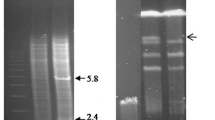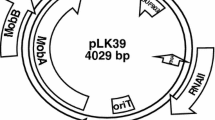Summary
Streptomyces lividans ISP 5434 contains four small high copy number plasmids: pIJ101 (8.9 kb), pIJ102 (4.0 kb), pIJ103 (3.9 kb) and pIJ104 (4.9 kb). The three smaller species appear to be naturally occurring deletion variants of pIJ101. pIJ101 and its in vivo and in vitro derivatives were studied after transformation into S. lividans 66.
pIJ101 was found to be self-transmissible by conjugation, to elicit “lethal zygosis” and to promote chromosomal recombination at high frequency in both S. lividans 66 and S. coelicolor A3(2). A restriction endonuclease cleavage map of pIJ101 was constructed for 11 endonucleases; sites for five others were lacking. Many variants of pIJ101 were constructed in vitro by inserting DNA fragments determining resistance to neomycin, thiostrepton or viomycin, and having BamHI termini, into MboI or BclI sites on the plasmid, sometimes with deletion of segments of plasmid DNA. The physical maps of these plasmids were related to their phenotypes in respect of lethal zygosis and transfer properties. In vivo recombination tests between pairs of variant plasmids were also done. These physical and genetic studies indicated that determinants of conjugal transfer occupy less than 2.1 kb of the plasmid. A second segment is required for spread of the plasmid within a plasmid-free culture to produce the normal lethal zygosis phenotype: insertion of foreign DNA in this region caused a marked reduction in the diameter of lethal zygosis zones. The minimum replicon was deduced to be 2.1 kb or less in size; adjacent to this region is a 0.5 kb segment which may be required for stable inheritance of the plasmid. The copy number of several derivatives of pIJ101 in S. lividans 66 was between 40 and 300 per chromosome and appeared to vary with the age or physiological state of the culture. pIJ101 derivatives have a wide host range within the genus Streptomyces: 13 out of 18 strains, of diverse species, were successfully transformed.
Knowledge of dispensable DNA segments and the availability of restriction sites for the insertion of DNA, deduced from the properties of plasmids carrying the E. coli plasmid pACYC184 introduced at various sites, was used in the construction of several derivatives of pIJ101 suitable as DNA cloning vectors. These were mostly designed to be non-conjugative and to carry pairs of resistance genes for selection. They include a bifunctional shuttle vector for E. coli and Streptomyces; a Streptomyces viomycin resistance gene of this plasmid is expressed in both hosts.
Similar content being viewed by others
References
Benigni R, Antonov RP, Carere A (1975) Estimate of the genome size by renaturation studies in Streptomyces. Appl Microbiol 30:324–326
Bibb MJ, Freeman RF, Hopwood DA (1977) Physical and genetical chracterization of a second sex factor, SCP2, for Streptomyces coelicolor A3(2). Mol Gen Genet 154:155–166
Bibb MJ, Hopwood DA (1981) Genetic studies of the fertility plasmid SCP2 and its SCP2* variants in Streptomyces coelicolor A3(2). J Gen Microbiol 126:427–443
Bibb MJ, Schottel JL, Cohen SN (1980) A DNA cloning system for interspecies gene transfer in antibiotic-producing Streptomyces. Nature (Lond) 284:526–531
Bibb MJ, Ward JM, Hopwood DA (1978) Transformation of plasmid DNA into Streptomyces at high frequency. Nature (Lond) 274:398–400
Bibb MJ, Ward JM, Kieser T, Cohen SN, Hopwood DA (1981) Excision of chromosomal DNA sequences from Streptomyces coelicolor forms a novel family of plasmids detectable in Streptomyces lividans. Mol Gen Genet 184:230–240
Birnboim HC, Doly J (1979) A rapid alkaline extration procedure for screening recombinant plasmid DNA. Nucl Acids Res 7:1513–1523
Chang ACY, Cohen SN (1978) Construction and characterization of amplifiable multicopy DNA cloning vehicles from the P15A cryptic miniplasmid. J Bacteriol 134:1141–1156
Chater KF, Hopwood DA (1982) Streptomyces genetics. In: Goodfellow M, Modarski M, Williams ST (eds) The actinomycetes. Academic Press, London (in press)
Chater KF, Hopwood DA, Kieser T, Thompson CJ (1982) Gene cloning in Streptomyces. Current Topics in Microbiol and Immunol 97:69–95
Chi NW, Ehrlich SD, Lederberg J (1978) Functional expression of two Bacillus subtilis chromosomal genes in Escherichia coli. J Bacteriol 133:816–821
Dagert M, Ehrlich SD (1979) Prolonged incubation in calcium chloride improves the competence of Escherichia coli cells. Gene 6:23–28
Daniels DL, De Wet JR, Blattner FR (1980) New map of bacteriophage lambda DNA. J Virol 33:390–400
Hayakawa T, Otake N, Yonehara H, Tanaka T, Sakaguchi K (1979) Isolation and characterization of plasmids from Streptomyces. J Antibiot 32:1348–1350
Hepburn AG, Hindley J (1979) Small-scale techniques for the analysis of recombinant plasmids. J Biochem Biophys Methods 1:299–308
Hintermann G, Fischer HM, Crameri R, Hütter R (1981) Simple procedure for distinguishing CCC, OC and L forms of plasmid DNA by agarose gel electrophoresis. Plasmid 5:371–373
Hopwood DA (1967) Genetic analysis and genome structure in Streptomyces coelicolor. Bacteriol Rev 31:373–403
Hopwood DA, Chater KF (1982) Cloning in Streptomyces: Systems and strategies. In: Setlow J, Hollaender A (eds) Genetic engineering, vol. 4. Plenum Press, New York (in press)
Hopwood DA, Chater KF, Dowding JE, Vivian A (1973) Advances in Streptomyces coelicolor genetics. Bacteriol Rev 37:371–405
Hopwood DA, Thompson CJ, Kieser T, Ward JM, Wright HM (1981) Progress in the development of plasmid cloning vectors for Streptomyces. In: Schlessinger D (ed) Microbiology-1981. ASM, Washington DC, pp 376–379
Lomovskava ND, Mkrtumian NM, Gostimskaya NL, Danilenko VN (1972) Characterisation of temperate actinophage C31 isolated from Streptomyces coelicolor A3(2). J Virol 9:258–262
Malik VS, Reusser F (1979) Restriction enzyme map for streptomycete plasmid pUC3. Plasmid 2:627–631
Maniatis T, Jeffrey A, van de Saude H (1975) Chain length determination of small double-and single-stranded DNA molecules by polyacrylamide gel electrophoresis. Biochemistry 14:3787–3794
Mayer H, Grosschedl R, Schütter H, Hobom G (1981) ClaI, a new restriction endonuclease from Caryophanon latum L. Nucl Acids Res 9, 4833–4845
McMaster GK, Samulski RJ, Stein JL, Stein GS (1980) Rapid purification of covalently closed circular DNAs of bacterial plasmids and animal tumor viruses. Anal. Biochem 109:47–54
Meacock PA, Cohen SN (1980) Partitioning of bacterial plasmids during cell division: a cis-acting locus that accomplishes stable plasmid inheritance. Cell 20:529–542
Miller JH (1972) Experiments in molecular genetics. Cold Spring Harbor Laboratory. Cold Spring Harbor N.Y.
Murray EN, Bruce SA, Murray K (1979) Molecular cloning of the DNA ligase gene from bacteriophage T4. II. Amplification and preparation of the gene product. J Mol Biol 132:493–505
Nakano MM, Ozawa K, Ogawara H (1980) Isolation and characterization of a plasmid pSL1 from Streptomyces lavendulae. FEMS Microbiol Lett 9:111–113
Okanishi M, Manome T, Umezawa H (1980) Isolation and characterization of plasmid DNA's in actinomycetes. J Antibiot 33:88–91
Pernodet J-L, Guerineau M (1981) Isolation and physical characterization of streptomycete plasmids. Mol Gen Genet 182:53–59
Schottel JL, Bibb MJ, Cohen SN (1981) Cloning and expression in Streptomyces lividans of antibiotic resistance genes derived from Escherichia coli. J Bacteriol 146:300–368
Schrempf H, Bujard H, Hopwood DA, Goebel W (1975). Isolation of covalently closed circular deoxyribonucleic acid from Streptomyces coelicolor. J Bacteriol 121:416–421
Southern EM (1979) Measurement of DNA length by gel electrophoresis. Anal Biochem 100:319–323
Sutcliffe JG (1978) pBR322 restriction map derived from the DNA sequence: accurate DNA size markers up to 4361 nucleotide pairs long. Nucl Acids Res 5:2721–2728
Thompson CJ, Ward JM, Hopwood DA (1980) DNA cloning in Streptomyces: resistance genes from antibiotic-producing species. Nature (Lond) 286:525–527
Thompson CJ, Ward JM, Hopwood DA (1982a) Cloning of antibiotic-resistance and nutritional genes in Streptomyces. J Bacteriol (in press)
Thompson CJ, Kieser T, Ward JM, Hopwood DA (1982b) Physical analysis of antibiotic-resistance genes from Streptomyces and their use in vector construction. Manuscript in preparation
Vivian A (1971) Genetic control of fertility in Streptomyces coelicolor A3(2): plasmid involvement in the interconversion of UF and IF strains. J Gen Microbiol 69:353–364
Author information
Authors and Affiliations
Additional information
Communicated by D. Sherratt
Rights and permissions
About this article
Cite this article
Kieser, T., Hopwood, D.A., Wright, H.M. et al. pIJ101, a multi-copy broad host-range Streptomyces plasmid: Functional analysis and development of DNA cloning vectors. Molec. Gen. Genet. 185, 223–238 (1982). https://doi.org/10.1007/BF00330791
Received:
Issue Date:
DOI: https://doi.org/10.1007/BF00330791




